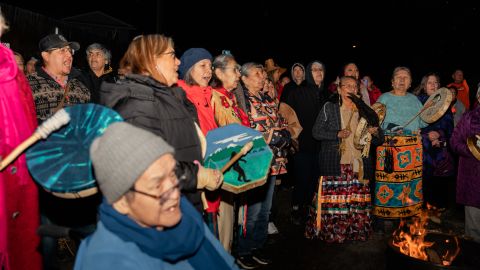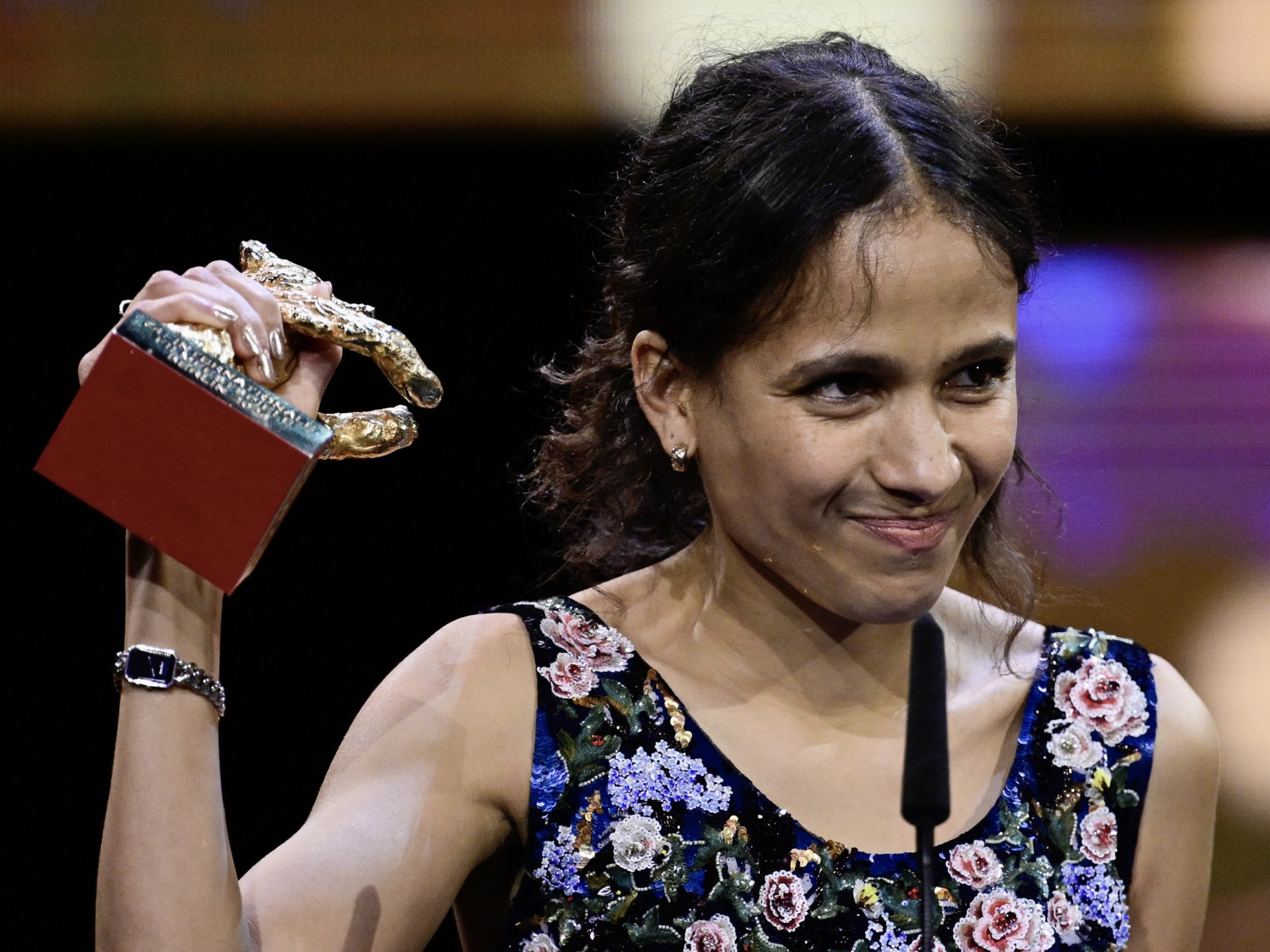The Nuxalk Nation’s totem pole was stolen and sold to a museum. After waiting 110 years, they finally have it back | CNN
CNN
—
A totem pole removed from an Indigenous burial site more than a century ago and kept on display in a Canadian museum has been repatriated to the Nuxalk Nation.
More than 100 Nuxalkmc traveled more than 600 miles from Bella Coola, British Columbia, to Victoria to reclaim their totem pole from the Royal BC Museum on Monday and bring it back to its rightful home.
As the totem pole was lifted out of the museum and lowered to the ground, its first time returning to Mother Earth, Nuxalkmc sang the Thunder Song – followed by women blessing and reawakening the totem’s spirit.
“We all cried when it landed on the ground,” Nuxalk Hereditary Chief Deric Snow told CNN. “It was the feeling when your emotions reach the highest point of your life. I’ve never dreamed we would be able to do this.”
The totem pole was carved in the mid-1800s by Snow’s great-grandfather Snuxyaltwa Louie Snow, whose spirit remains in the totem pole and will not be at rest until it is returned to its ancestral home, the chief said.
“The people who carved their totem poles were so spiritual, they were chosen to be carvers, they asked the tree to give itself up to them before carving it, they had visions on what to put on there,” Snow said. “Everything in the Royal BC Museum is sacred because they were created by gifted people and their spirits are still in them.”
The totem pole, which was used as a longhouse entrance pole and then a grave post, was removed from a burial site and sold to the museum in 1913 for 45 Canadian dollars, according to museum records. The pole was one of many artifacts left behind when the smallpox epidemic drove Indigenous people out of their homelands in 1900, according to Snow.
Since tradition says the spirit of the carver forever remains in their totem pole, keeping it inside a museum for 110 years meant Snow’s great-grandfather’s spirit has been trapped in a gallery room, Snow said.
“To us, museums are just like the residential schools where our children were killed,” Snow said. “They have human remains in the Royal BC museum, and the spirits of these human remains are there. It’s a type of pain that we can’t put into our words.”
During his fight to get the totem pole back from the museum – as well as a second totem pole and a war canoe that he says his great-grandfather also carved – Snow lost his wife, brother, and sister in 2022.
“It was a very difficult time and we weren’t supposed to be doing any work,” Snow said. “But we got through it by remembering who we’re doing it for and doing it with love. I know my wife is in heaven smiling down and rejoicing with us. “
Snow first requested the repatriation of the totem pole after seeing it in the museum in 2019. After years of discussions, he filed a lawsuit against the museum in February 2022 in hopes of hastening its return.
“The museum committed to repatriation of the pole in 2019 but this particular case has presented some challenges that have lengthened the process,” the Royal BC Museum told CNN. “There was a diligent process to confirm ownership and the need to create a plan to remove the pole located on the third floor of the museum. Covid-19 also caused a delay.”
The museum said staff worked closely with Snow “to create a secure plan for the removal of the pole from the First Peoples gallery,” which involved a team of engineers, conservationists and experts.
“We will continue conversations regarding other belongings with the Nuxalk Nation as soon as we are able to do so,” the museum said, adding that they have repatriation requests from 30 other Indigenous tribes in the province.
A convoy of more than 60 cars followed the vehicle carrying the totem pole during its 14-hour drive back home. On the journey, the Nuxalkmc stopped to visit seven other First Nation tribes so they could see the totem pole, feel its energy. and bless it with sage and cedar bow.
“Totem poles tell you everything in your life and why you’re here on Mother Earth. We are here to live but also to be the voice of all life,” Snow said. “We speak for every living thing on Mother Earth, including the water, the air, the mountains, all the animal kingdom, and every nation is reminded of that just by us going by them with a totem pole.”
Some of the tribes also hosted the Nuxalkmc, celebrating together with feasts, singing, drumming and dancing to honor the reawakened spirit and rejoice in the victory of the totem pole’s return.
“This is the beginning,” Trevor Mack, a member of the Tsilhqot’in Nation who attended one of the celebrations as the pole made its journey, told CNN. “Museums all throughout the western world – whether they be in Victoria, Chicago, New York, London, Paris – will need to prepare for the stolen objects in their glass cases being called home, to where they belong.”
While the healing process for Indigenous people includes the repatriation of everything taken from them, celebrations like those inspired by the return of the totem pole are just as important.
Its impact was visible in the laughter and cries of the hundreds of tribal members who came out to honor the pole’s journey at the Williams Lake First Nation in Secwepemc territory, one of the tribes the convoy visited along the way.
The celebration began outside with two fires lit as elder tribal women blessed everyone with a healing song. They then took fur bows and blessed the pole while the elders drummed.

“As we were drumming the welcoming song, the elder women from our nation suddenly, without being asked, got up and began doing the welcoming dance,” Williams Lake First Nation Chief Willie Sellars told CNN. “It broke me down. It got very emotional for a lot of people because we don’t see these things happen often.”
“The legacy and history of residential schools and the trauma that was inflicted on my ancestors and elders that are still alive today has never left us,” he added. “To see them still be able to hold on to our traditions and pass it down from generation to generation makes you so proud to be Indigenous.”
Recently, most large gatherings in Indigenous communities have been for funerals, especially following the Covid-19 pandemic, which ravaged Indigenous communities who struggled to get resources and medical care.
For so many different tribes to unite in joyous celebrations rather than mourning, Sellars said, was a “moment that meant everything.” It was also a reminder of what life once looked like for their ancestors before so much was taken from them.

“Historically, we would gather as nations and we would celebrate, until we weren’t allowed to have the ceremonies or speak our language or sing our songs,” Sellars said. “It’s so emotional because it means we are finally heading in the right direction. This totem pole is a beacon of hope for all of us.”
The following day, the pole was blessed by elders at the Tsilhqot’in community of Tl’etinqox. After, the pole and convoy trekked down a snow laden mountain road back into Bella Coola.
The totem pole will be at the Acwsalcta School on the reservation in Bella Coola until a final ceremony to reawaken Snow’s great-grandfather takes place on May 5, 2024, in honor of his wife who passed away on that date last year. The totem pole will then be returned to its original site in South Bentinck.
“Every time something returns to us, we get more and more of our stories back,” Snow said. “It’s time for the Canadian government to see us as people. They all know what’s been stolen and they have to give back what they have taken.”




